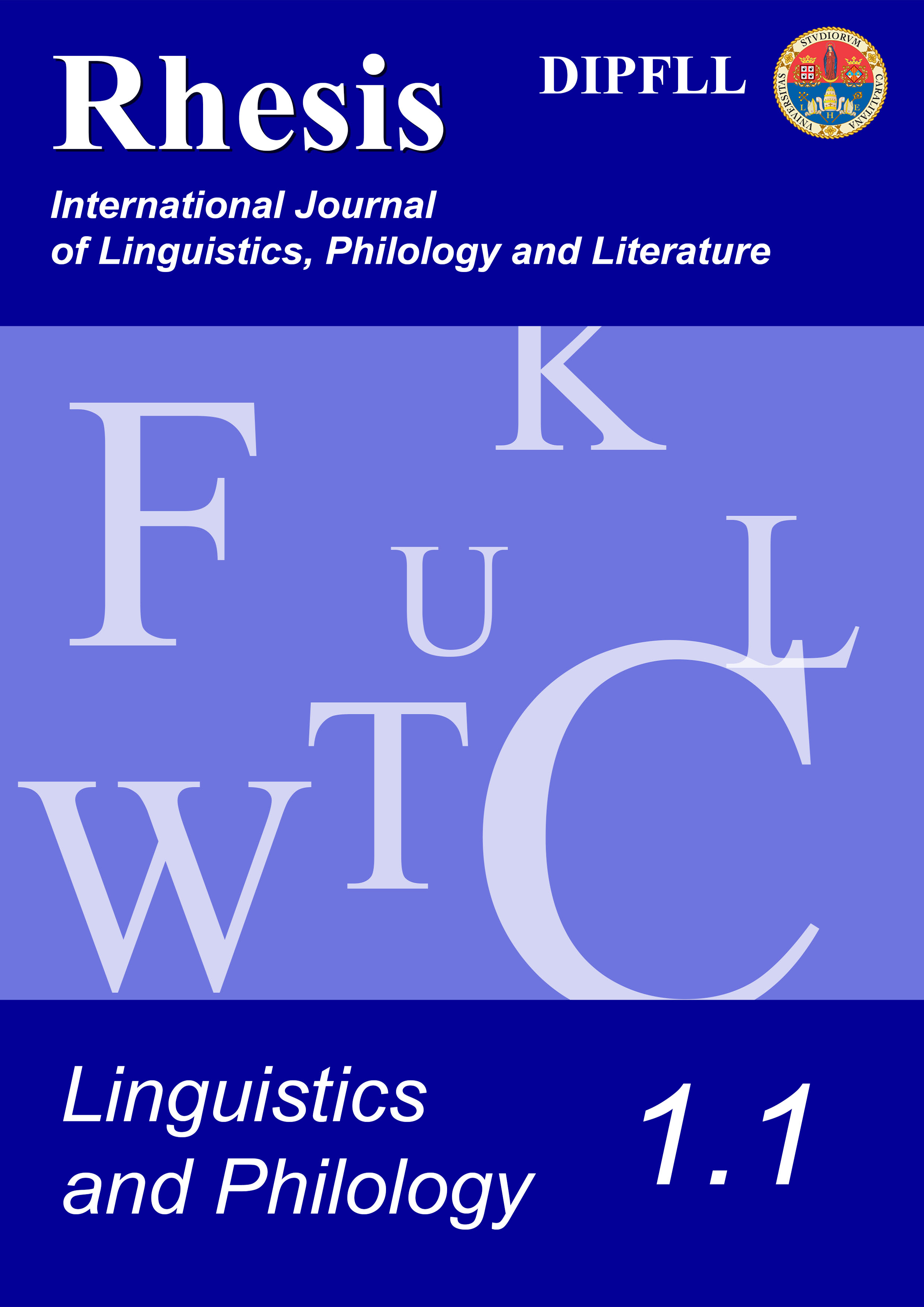“Old England of thy sins in time repent […]”: Religious lexis and discourse in 17th century Broadside Ballads
Abstract
This paper draws on the Bodleian Allegro Catalogue to examine a group of 17th religious broadside ballads. In particular I show that the Protestant broadside is a stylistically hybrid text where features of traditional ballads merge with 1) lexico-syntactic loans from the Holy Scriptures and 2) properties of religious prose style (i.e. interest in content, discourse cohesion, intrusive author). In the first part of my study I outline the specificity of the godly broadside as distinct from popular ballads. In the second part I focus on three apocalyptic broadsides and I analyse them in terms of discourse construction, collocation and prosodic features. Similarities in text organization highlight the use of formulaic patterns which reflect the Puritan stance in relation to the themes of repentance, God's Judgement and divine retribution. Borrowings from the language of the Prophetic Books, on the other hand, document the importance ascribed to intertextuality as a means of 1) enhancing the value of the ballad-content and 2) satisfying people's preference for themes they were already familiar with from their knowledge of the Bible or from their attendance of religious services. This latter aspect testifies to the major role played by the audience in the construction/representation of religious discourse.
Downloads
References
CECCONI, Elisabetta. 2009. “Comparing seventeenth century news broadsides and occasional news pamphlets: Interrelatedness in news reporting”. In Andreas H. JUCKER (ed.), Early Modern English News Discourse. Newspapers, pamphlets and scientific news discourse, 137-157. Amsterdam/Philadelphia: John Benjamins.
CHILD, Francis James. 1882-1894 (1965). The English and Scottish Popular Ballads: in five volumes. New York: Cooper Square.
COLLINSON, Patrick. 1988. The Birthpangs of Protestant England. Houndmills: MacMillan Press.
DUFFIN, Charles. 2004. “Echoes of Authority: audience and formula in the Scots ballad text”. In Richard Firth GREEN and Philip E. BENNETT (eds.), The Singer and The Scribe: European Ballad Traditions And European Ballad Cultures, 135-151. New York: Rodopi.
DUFFY, Eamon. 1986. “The godly and the multitude in Stuart England”. In «The Seventeenth Century Journal» 1. 31-49.
FIRTH, John Rupert. 1930 (1964). The Tongues of Men and Speech. London: Oxford University Press.
FIRTH, John Rupert. 1935. “The Techniques of Semantics”. In «Transactions of the Philological Society» 34(1). 36-73.
FÓNAGY, Ivan. 1971. “Double coding in speech”. In «Semiotica» 3. 189-222.
FÓNAGY, Ivan. 1991. La vive voix: essais de psycho-phonetique. Paris: Payot.
FÓNAGY, Ivan. 2000. “Languages of Iconicity”. In Patrizia IOLI (ed.), Phonosymbolism and Poetic Language, 57-84. Turnhout, Belgium: Brepols Publishers
FOX, Adam. 2000. Oral and Literate Culture in England 1500-1700. Oxford: Oxford University Press.
GREEN, Ian M. 1996. The Christian’s ABC: catechism and catechising in England 1530- 1740. Oxford: Oxford University Press.
GREENE, Richard Leighton. 1935 (1977). The Early English Carols. Oxford: Clarendon Press (2nd edn, rev. and enlarged).
KING, John. 1982. English Reformation literature: the Tudor origins of the Protestant tradition. Princeton: Princeton University Press.
LEECH, Geoffrey N. 1969. Linguistic Guide to English Poetry. Harlow: Pearson Education.
PARRY, Milman. 1971. The Making of Homeric Verse. Oxford: Clarendon Press.
POUND, Louise. 1921. Poetic Origins and the Ballad. New York: Macmillan.
RAYMOND, Joad. 2003. Pamphlets and Pamphleteering in Early Modern Britain. Cambridge: Cambridge University Press.
RICHMOND, Winthrop Edson. 1989. Ballad Scholarship: An Annotated Bibliography. New York: Garland.
RUBIN, David C. 1995. Memory in Oral Traditions: The Cognitive Psychology of Epic, Ballads, and Counting-out Rhymes.New York: Oxford University Press. The Bodleian Allegro Catalogue of Broadside Ballads (from the 16th to the 20th century). http://www.bodley.ox.ac.uk/ballads/ballads.htm
The Holy Bible: containing the Old and New Testaments in the authorized King James version. 1960. Chicago: Good Counsel Company.
TSUR, Reuven. 1992. What makes sound patterns expressive? Durham, NC: Duke University Press.
VIOLI, Patrizia. 2000. “Introduction”. In Patrizia VIOLI (ed.), Phonosymbolism and Poetic Language, 7-24. Turnhout, Belgium: Brepols Publishers
WALSHAM, Alexandra. 1999. Providence in Early Modern England. Oxford: Oxford University Press.
WATT, Tessa. 1991. Cheap Print and Popular Piety 1550-1640. Cambridge: Cambridge University Press.
WAUGH, Linda R. 2000. “Against arbitrariness: Imitation and motivation revived”. In Patrizia VIOLI (ed.), Phonosymbolism and Poetic Language, 25-56. Turnhout, Belgium: Brepols Publishers
WHISSELL, Cynthia. 1999. “Phonosymbolism and the emotional nature of sounds: evidence of the preferential use of particular phonemes in texts of differing emotional tone”. «Perceptual and Motor Skills» 89. 19-48.
WÜRZBACH, Nathalie. 1990. The Rise of the English Street Ballad, 1550-1650. Cambridge: Cambridge University Press.



